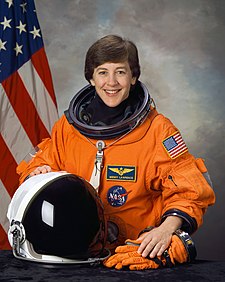Wendy Barrien Lawrenceová
| Wendy Barrien Lawrenceová | |
|---|---|
 Wendy Barrien Lawrenceová | |
| Astronaut NASA | |
| Státní příslušnost | |
| Datum narození | 2. července 1959 (63 let) |
| Místo narození | Jacksonville, Florida |
| Předchozí zaměstnání | pilotka |
| Hodnost | kapitán námořnictva |
| Čas ve vesmíru | 51 dní, 3 hodiny a 56 minut |
| Kosmonaut od | 1992 |
| Mise | STS-67, STS-86, STS-91, STS-114 |
| Znaky misí | |
| Některá data mohou pocházet z datové položky. | |
Wendy Barrien Lawrenceová (* 2. července 1959 Jacksonville, Florida), je americká letkyně, důstojnice a kosmonautka. Ve vesmíru byla čtyřikrát.
Život
Studium a zaměstnání
Absolvovala střední školu Fort Hunt High School v městě Alexandria ve Virginii a pak pokračovala ve studiu na Námořní akademii Spojených států amerických. Ukončila jej v roce 1981.
Po několika letech pokračovala ve vysokoškolském studiu na Massachusettském technologickém Institutu a Woods Hole Oceanographic Instition. Sloužila jako armádní pilotka helikoptéry.
Od roku 1992 byla členkou jednotky kosmonautů NASA v Houstonu.
Lety do vesmíru
Na oběžnou dráhu se v raketoplánech dostala čtyřikrát vždy s funkcí letové specialistky, byla na orbitálních stanicích Mir i ISS a strávila ve vesmíru 51 dní, 3 hodiny a 56 minut. Byla 323. člověkem ve vesmíru, 28. ženou.
- STS-67 Endeavour (2. března 1995 – 18. března 1995)
- STS-86 Atlantis (26. září 1997 – 6. října 1997)
- STS-91 Discovery (2. června 1998 – 12. června 1998)
- STS-114 Discovery (26. července 2005 – 9. srpna 2005)
Odkazy
Externí odkazy
 Obrázky, zvuky či videa k tématu Wendy Barrien Lawrenceová na Wikimedia Commons
Obrázky, zvuky či videa k tématu Wendy Barrien Lawrenceová na Wikimedia Commons - Na webu Space
- Na webu MEK-Kosmo
Média použitá na této stránce
The STS-86 flight was the seventh shuttle-Mir docking mission, symbolized by seven stars. The international crew includes astronauts from the United States, Russia, and France. The flags of these nations are incorporated in the rays of the astronaut logo. The rays of light streaking across the sky depict the orbital tracks of the two spacecraft as they prepare to dock. During the flight, an American astronaut and a Russian cosmonaut will perform an extravehicular activity (EVA). The mercator projection of Earth illustrates the global cooperative nature of the flight.
Emblem of Nasa's STS-114 mission.
- The STS-114 patch design signifies the return of the Space Shuttle to flight and honors the memory of the STS-107 Columbia crew. The blue Shuttle rising above Earth’s horizon includes the Columba constellation of seven stars, echoing the STS-107 patch and commemorating the seven members of that mission. The crew of STS-114 will carry the memory of their friends on Columbia and the legacy of their mission back into Earth orbit. The dominant design element of the STS-114 patch is the planet Earth, which represents the unity and dedication of the many people whose efforts allow the Shuttle to safely return to flight. Against the background of the Earth at night, the blue orbit represents the International Space Station (ISS), with the EVA crewmembers named on the orbit. The red sun on the orbit signifies the contributions of the Japanese Space Agency to the mission and to the ISS program. The multi-colored Shuttle plume represents the broad spectrum of challenges for this mission, including Shuttle inspection and repair experiments, and International Space Station re-supply and repair.
STS-67 Mission Insignia
Astronaut Wendy B. Lawrence, mission specialist.
This is the crew patch for the STS-91 mission – the ninth flight of the Shuttle-Mir Phase One docking missions. The crew will bring back Andrew S. W. Thomas, the last long-duration American crew member flown on the Russian Space Station Mir. This mission marks the end of the Shuttle-Mir Phase One Program and will open the way for Phase Two: construction of the International Space Station (ISS).
The crew patch depicts the rendezvous of the Space Shuttle Discovery with the Space Station Mir. The flags of the United States and Russia are displayed at the top of the patch and both countries are visible on the Earth behind the two spacecraft. The names of the American crew members surround the insignia on the outer areas, with the name of cosmonaut Valeriy Ryumin in Cyrillic at the lower right.





